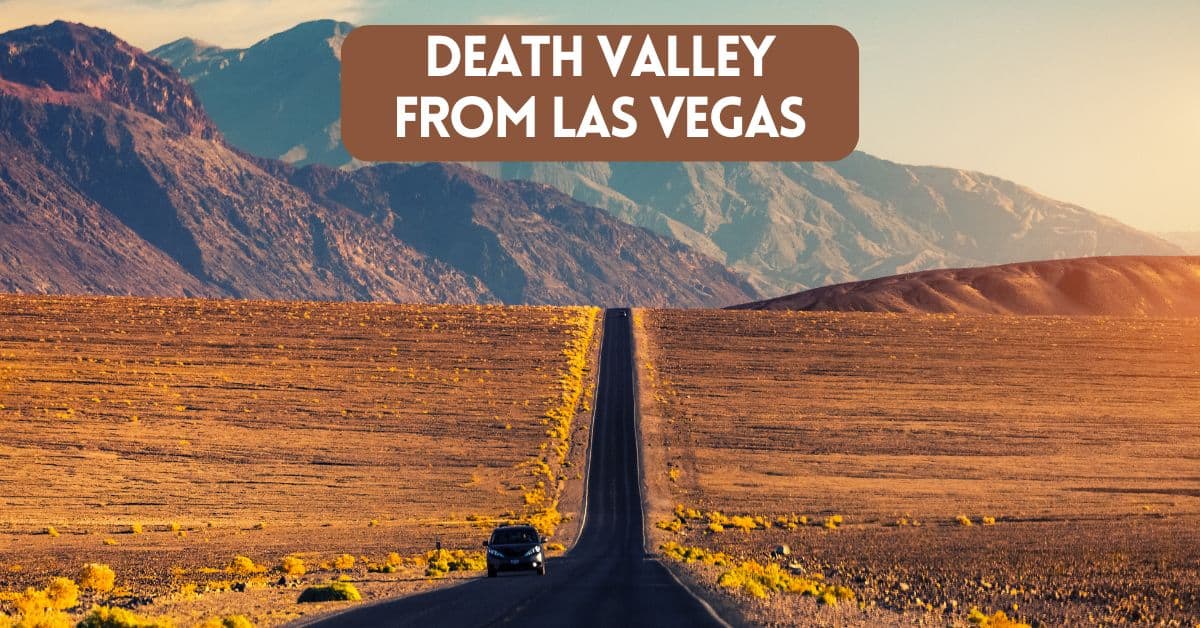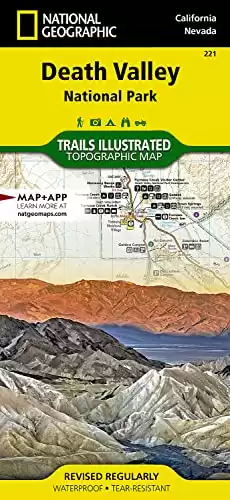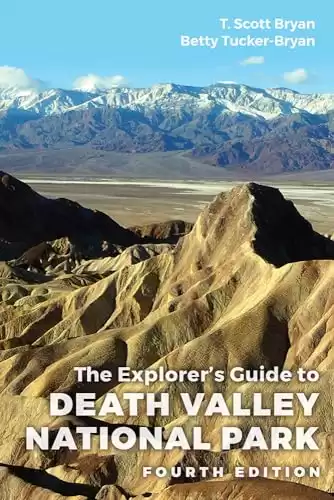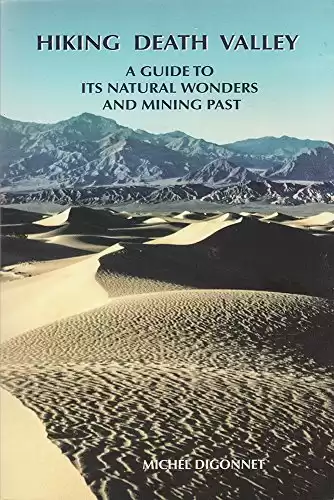How to Get from Las Vegas to Death Valley National Park
Death Valley National Park, known for its stunningly unique landscapes and extreme climate, is a popular day trip or weekend getaway from Las Vegas. Here’s a comprehensive guide on how to get to Death Valley from Las Vegas, including driving directions, time estimates, vehicle recommendations, and options for public transport and tours.
The Places Where We Go contains affiliate links and is a member of the Amazon Services LLC Associates Program. As an Amazon Associate, we earn from qualifying purchases at no extra cost to you when you purchase using one of these Amazon links. Read our disclaimer and privacy policy for more information.
Driving from Las Vegas to Death Valley
Route Overview: The most direct route and easiest way to drive from Las Vegas to Death Valley is via NV-160 W and Bell Vista Avenue. This journey takes about two hours without stops. If you leave very early, you can have enough time to see some top sights and have a great time in this national park.
Driving Directions:
- Start in Las Vegas: Head west on NV-160 W (Blue Diamond Road).
- Pahrump: After about an hour, you’ll reach the town of Pahrump, which is a great place to refuel, grab some snacks, and use restrooms before continuing.
- Bell Vista Avenue: Continue through Pahrump, turning onto Bell Vista Avenue, which takes you directly to Death Valley Junction.
- California Route 190: From Death Valley Junction, continue on CA-190 W, the main road into the park. This route leads to Furnace Creek, a hub with amenities, trailheads, and visitor services.
Estimated Driving Time: The travel time is about a two-hour drive – (120 miles), depending on traffic and stops.
Get Free Weekly Travel News Updates

Best Vehicles for the Journey
- Standard Cars: A regular car is sufficient for most of the year. The roads are paved and in good condition.
- SUVs or higher clearance vehicles are recommended for exploring off-road areas. While the main roads are paved, gravel and dirt roads lead to more remote areas. An SUV provides more comfort and security, especially in rougher terrain.
- Four-Wheel Drive (Optional): This is only necessary if you plan to explore deeper into remote areas of the park, where road conditions can become challenging.
Note: Avoid driving low-clearance sports cars or other vehicles sensitive to extreme heat, especially in summer. Temperatures can exceed 120°F (49°C), adding strain on vehicles. Ensure your vehicle is in good working condition, with a full tank, coolant, and reliable air conditioning.
Public Transportation and Tours
While Death Valley is not easily accessible via public transport, there are a few options for those who prefer not to drive:
- Tour Companies:
- Several companies in Las Vegas offer day trips or overnight tours to Death Valley. These guided trips provide round-trip transportation, ideal for those unfamiliar with desert driving.
- Tours often include stops at iconic sites like Badwater Basin, Zabriskie Point, and Dante’s View and provide commentary on the region’s geology and history.
- If you want to visit just for one day, you’ll find day tour options from various tour companies.
- Public Transportation:
- Currently, there is no direct public bus service from Las Vegas to Death Valley. The closest public transit option would be to take a bus to Pahrump, but you would still need a car or tour from there.
- Renting a vehicle or joining a tour remains the most feasible way to reach Death Valley from Las Vegas without driving your car.
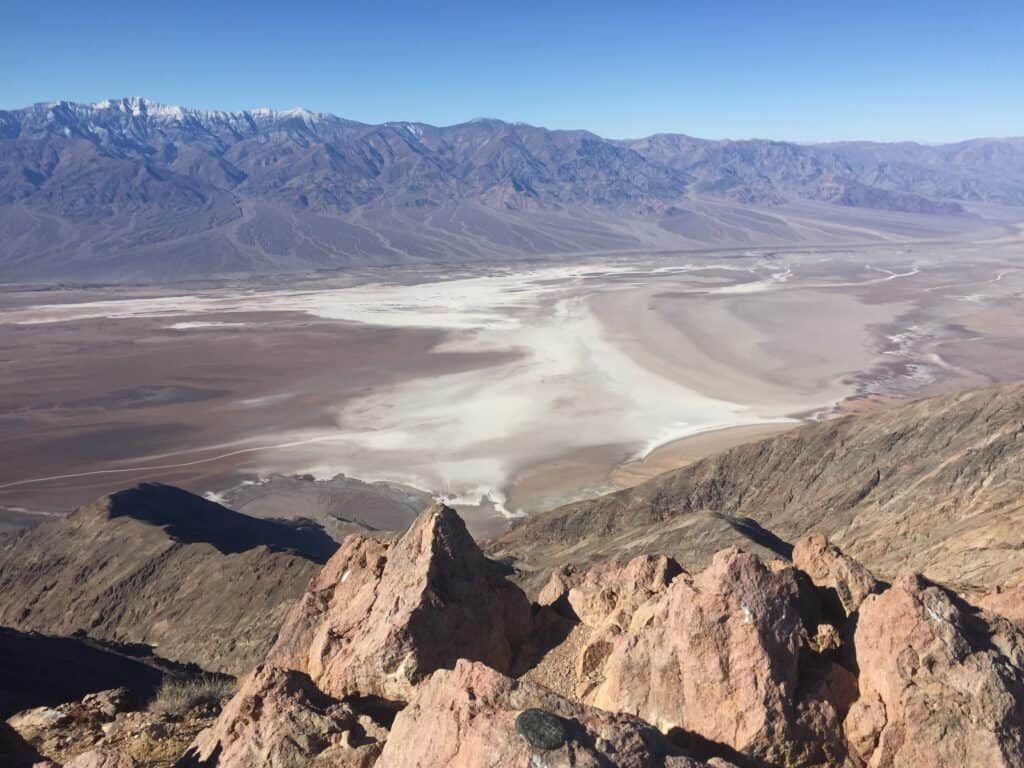
Entering Death Valley National Park
As you approach the park’s entrance, it’s important to note that a park entrance fee is required to gain access. Visitors can conveniently pay this fee at self-service kiosks located at the park’s major entrances, such as the Furnace Creek Visitor Center. Payment can also be made online through the National Park Service’s website prior to your visit.
Essential Tips for Driving to Death Valley
- Plan for Limited Cell Service: Cell phone service is minimal once inside the park, especially in remote areas. Download maps or use a GPS device that works offline.
- Fuel Up in Pahrump: Fuel stations are limited within the park, and gas prices are significantly higher. The last major gas station before the park is in Pahrump, so fill up there. Check out our article about gas stations in Death Valley.
- Bring Plenty of Water: Death Valley’s extreme conditions mean you should always have ample water. Plan for at least 1-2 gallons per person.
- Prepare for Extreme Temperatures: Death Valley can experience drastic temperature changes even in the winter months. Check the weather forecast before heading out, and dress in layers.
- Best Time to Visit: Fall and spring are ideal, as temperatures are moderate. Avoid the summer months, especially if you’re not experienced with desert driving.
Must-See Stops Along the Way
- Pahrump: Great for a pit stop, and it’s worth visiting if you have extra time. There are casinos, local restaurants, and even a winery.
- Furnace Creek Visitor Center: Start your Death Valley experience here. The center offers detailed maps, guides, and information on current conditions and any road closures.
- Scenic Overlooks and Attractions:
- Furnace Creek Visitor’s Center: start your visit here to get the latest updates on conditions in the park during your visit.
- Badwater Basin: The lowest point in North America, at 282 feet below sea level where you can see the amazing salt flats. We recommend walking out on this valley floor for a short walk during your visit.
- Zabriskie Point: Offers one of the most iconic views in Death Valley. Check out Zabriskie Point especially during sunrise and sunset when you can see spectacular views of the landscape.
- Dante’s View: Located at 5,475 feet, this overlook provides panoramic views of the valley.
- Mesquite Sand Dunes: The Mesquite Flat Sand Dunes are a picturesque landscape of rolling hills and shifting sands.
- Devil’s Golf Course :- The Devil’s Golf Course in Death Valley is a unique natural wonder, with jagged and rough salt formations that resemble a golf course from hell.
Why Visit Death Valley National Park from Las Vegas
Death Valley National Park, located in the United States, is a great add-on destination if you’re exploring the vibrant city of Las Vegas. As the largest national park in the contiguous U.S., this remarkable area offers a unique escape into the vast and captivating Mojave Desert.
If you want more ideas for your Death Valley itinerary, check out our post about planning a perfect day in Death Valley National Park – a one day itinerary. You’ll find plenty of ideas for things to do during your Las Vegas to Death Valley road trip.
Death Valley National Park – Know Before You Go
✈️ Closest Airport: Las Vegas McCarren (LAS)
⏰ Time Zone: Pacific Standard Time (GMT-8)
Staying Overnight in Death Valley?
Final Thoughts
Visiting Death Valley from Las Vegas offers a chance to experience one of the world’s most extraordinary natural environments. Whether you drive yourself or take a guided tour, prepare well and respect the desert’s unique conditions. For a change of pace from the casinos of Las Vegas, a Death Valley day trip will provide a memorable addition to your Vegas visit.
Thanks for reading this article about driving from Las Vegas to Death Valley National Park.
Safe travels!
|
Primary Rating:
4.8
|
Primary Rating:
4.8
|
Primary Rating:
4.7
|
|
$11.80
|
$24.95
|
$14.41
|

